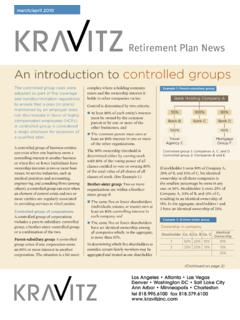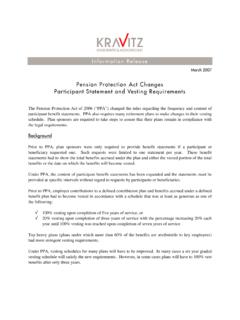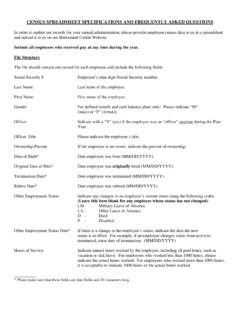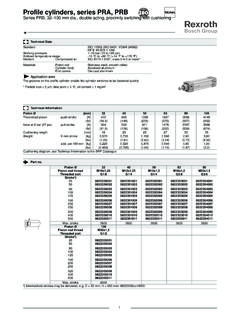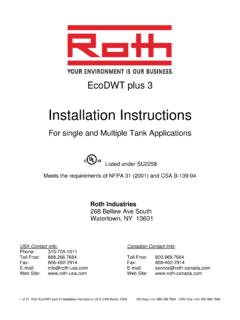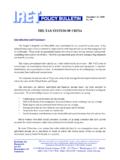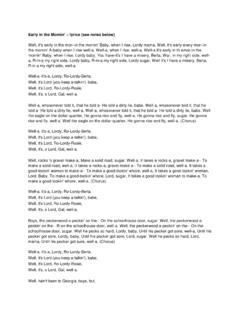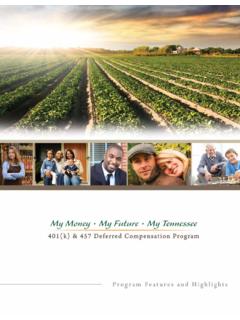Transcription of All in the family: Attribution rules - Kravitz, Inc.
1 July/august 2011To preserve favorable taxtreatment, qualified retirementplans must not discriminate infavor of highly compensatedemployees (HCEs) with respectto contributions and members who participatein the plan are often HCEs. They may also be key employees, whichraises another concern: If the accounts ofkey employees make up 60% or more ofplan benefits, the plan becomes topheavy. For a top-heavy defined contribu-tion plan, if a contribution is made onbehalf of or a deferral is made by any keyemployee (or a benefit accrues in a top-heavy defined benefit plan), thenminimum contributions must be made toparticipants who are not key Attribution of ownership rules alsoplay a is an HCE?A plan participant becomes an HCE inone of two ways: through ownership orcompensation. According to thedefinition, a highly compensatedemployee is either: An owner, at any time during thecurrent plan year or the immediatelypreceding plan year, of a more than5% interest in the business sponsoringthe retirement plan (a 5% owner) or An employee who earned at least$110,000 in the immediately precedingplan year from this employer.
2 (Thisfigure is adjusted for inflation.)Any employee who does not meet eitherstandard is a nonhighly compensatedemployee (NHCE).Who is a key employee?A key employee is a plan participantwho, at any time during theimmediately preceding plan year, was: An officer of the business sponsoringthe retirement plan earning morethan $160,000 (adjusted for inflation), A 5% owner (owns more than 5%), or A 1% owner (owns more than 1%)who earns more than $150, employee who does not meet one ofthese standards is a nonkey that these definitions do notoverlap. An individual may be an HCEbut not a key employee and vice , it is possible to be both, ,an individual who was a 5% owner in theprior plan is Attribution of ownership? Attribution is a legal concept that treatstwo or more people as owning thesame interest in a business entity thatis directly owned by one of them or bya third party. Under pension law,indirect ownership through attributionfrom a family member has the samestatus as direct ownership.
3 This is toprevent discrimination against rank-and-file participants when testing fornondiscrimination (regarding theallocation of contributions andbenefits) and may cause a determina-tion that the top-heavy minimumcontribution requirements apply to theplan. However, family Attribution neverapplies when the determination ofHCE or key employee status is basedsolely on the employee s , the Attribution of ownershiprules apply only to a spouse (as definedunder federal tax law) and linealascendants and descendants of thedirect owner. (See table on page 2.) In(Continued on page 2) all in the family : Attribution rulesLos Angeles New YorkAtlanta Las Vegas Denver Washington DCSalt Lake City Ann Arbor Charleston(877) Plan Newsthe case of a spouse, Attribution continuesuntil the individuals are either formallydivorced or legally separated under relevantstate law. What is the impact of Attribution ?Although the principal intent of theattribution rules is to prevent themanipulation of the qualified plan rules , Attribution can be a double-edged sword.
4 Forexample, Attribution may increase thenumber of individuals included in the HCEclass for nondiscrimination on how much the additionalHCEs defer to a 401(k) plan, the resultingaverage deferral percentage (ADP) for thewhole HCE class may be higher or careful planning, this may present anopportunity to maximize allowable deferralsfor HCEs and key employees. On the other hand, Attribution may be asignificant impediment. As an example, across-tested plan design is used and theowner s son or daughter is hired to work forthe firm. In a cross-tested plan, both age andcompensation are taken into account fordiscrimination testing purposes. Familyattribution gives the owner s children thesame ownership percentage as theparent/owner. Thus, the child would bebrought into the HCE class when testing theallocation of contributions. This will likelycause the cross test to fail. As a result,additional contributions would have to bemade on behalf of NHCEs. It is also important to identify HCEs ( , themarried daughter of an owner who has adifferent last name) when submitting acensus for ADP or ACP testing.
5 Since familymembers without their own direct ownershipare HCEs under the family Attribution rules ,understanding the rules helps the employerand plan administrator determine the correcttest results. Important issuesAttribution has a significant impact on plandesign and administration. The ownershipattribution rules also play a significant role indetermining whether controlled and affiliatedgroups exist. It is prudent to discuss theseconcepts with your retirement plan in the family : Attribution rules (Continued from page 1) Attribution type*Section 318 rulesExample:SpouseDeemed to own the stock**John would be considered to own the stock of hiswife would be considered to own the stock of herhusband to child younger than age 21 Deemed to own the stockHank, Jim, and Sarah would each be consideredto own the stock of their to child older than age 20 Deemed to own the stockChild to parentDeemed to own the stockJohn and Mary would each be considered to ownthe stock of their three to grandparentDeemed to own the stockJohn and Mary would also be considered to ownthe stock of their to grandchildNo attributionJohn and Mary s grandchildren would notbeconsidered to own the stock of John and lineal ancestors anddescendantsNo attributionThe parents of John and Mary do not attribute toJohn and Mary s , sisters, and half-siblingsNo attributionNeither Hank, nor Jim, nor Sarah is considered toown each other s stock.
6 Sisters and brothers arenot part of the family Attribution of lineal descendantsNo attributionThe spouses of Hank, Jim, and Sarah would notown the stock of Mary and John. In-laws are notpart of the family Attribution rules .* There are also Attribution rules for partnerships, estates, trusts, and corporations.** Unless divorced (final decree only) or Internal Revenue Code defines family relationships for the purpose ofownership in most retirement plan applications. According to Section 318(a)(1):A. An individual shall be considered as owning the stock owned, directlyor indirectly, by or for(i) His or her spouse (as determined under federal tax law, not state, andother than a spouse who is legally separated from the individual undera decree of divorce or a separate maintenance) and (ii) His or her children, grandchildren, and parents. B. Effect of adoption: A legally adopted child of an individual shall betreated as a child of such individual by a hypothetical family : Spouses/parents: John and MaryChildren: Hank (age 27), Jim (age 24), and Sarah (age 17) all in the family : A closeupBeneficiary distribution optionsin 2011 Qualified retirement plandocuments, such as 401(k) plans,have default provisions to covervarious beneficiary scenarios,including the possibility that aparticipant failed to designate abeneficiary prior to death or that adeceased participant s beneficiaryform may be invalid or missing.
7 Other thorny issues can arise, such as abeneficiary predeceasing the participantor a life changing event ( , a divorceand/or remarriage) occurring afterabeneficiary designation form was filed. Administrators are encouraged to reviewthe plan s beneficiary designation forms ona regular basis (at least once every fiveyears) to confirm that each participant hasa current form on file. Also, participantsshould be educated about the importanceof reviewing their beneficiary forms everyfive years (or sooner, if there is a reason).Failure to do so could result in distributionsthat do not conform to participants wishesor fulfill their estate plans. Marital status Marital status should be addressed aspart of the participant s beneficiarydesignation since there are laws thatprotect a spouse as the primarybeneficiary of a married procedures must be followed topermit a bona fide waiver, , consentmust be in writing and be witnessed by anotary public or plan that some states currently allowsame-sex marriages.
8 However, federallaws, protections, and requirements donot apply to such beneficiaryA spouse beneficiary may generally roll over qualified plan funds into his or her own IRA or qualified plan (if thereceiving qualified plan accepts rollovers).Alternatively, the spouse may leave thefunds in the participant s plan until the endof the year in which the decedent wouldhave attained age 701/2. If the decedent wasunder age 701/2and the beneficiary is overage 701/2, this could be advantageous. A spouse may establish a life expectancypayout based on his or her own lifeexpectancy. The spouse s age is used todetermine the distribution factor from theIRS single life expectancy table in the yeardistributions begin and each subsequentyear. A spouse may name a beneficiary and,when the spouse dies, payments cancontinue over the spouse s remaining lifeexpectancy at that point (reduced by oneeach year). The spouse s beneficiary maynot use his or her own life expectancy.
9 Some surviving spouses prefer to rollover the funds to their own IRAs so thattheirbeneficiaries can use their own lifeexpectancies to stretch out paymentswhen the IRA owner dies. Nonspouse beneficiaryA nonspouse beneficiary may directly rollover qualified plan funds into an inheritedIRA. If a life expectancy payout is elected,the age of the nonspouse beneficiary isused to determine the distribution factorfrom the IRS single life expectancy table.(The distribution factor is then reduced byone in years following the initialdistribution year.) Conversion to an inherited Roth IRAE ffective in 2008, a spouse or nonspousebeneficiary may now convert qualifiedplan funds to an inherited Roth IRA,provided the individual can pay the taxesin the year of conversion. An in-planrollover to a designated Roth may only bemade by a spouse beneficiary. RMDs in the year of deathIf the participant was receiving requiredminimum distributions (RMDs), thedecedent s RMD for the year of death muststill be paid.
10 The beneficiary may thenbegin receiving life expectancy distribu-tions based on his or her life expectancythe following year. A nonspouse beneficiarywho is a person (as opposed to a charity orsimilar entity without a life expectancy)may use his or her life expectancy tocalculate the minimum payout using theIRS single life expectancy table. (The lifeexpectancy factor is reduced by one foreach year thereafter when calculatingsubsequent payments.)Decision deadlineA beneficiary generally must decide howto take a distribution by September 30 ofthe year after the year of the participant sdeath. The options are to: Take the entire benefit in a lump sum, Establish a life expectancy payoutarrangement commencing no laterthan the last day of the calendar yearfollowing the participant s death, Disclaim his or her beneficiary rights, or Receive payment (either periodically orin a lump sum) of the entire benefit bythe last day of the fifth year followingthe year of the participant s death.

